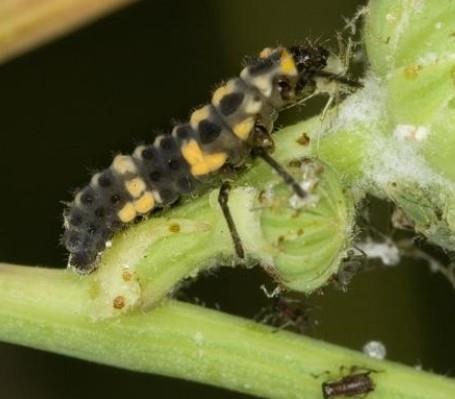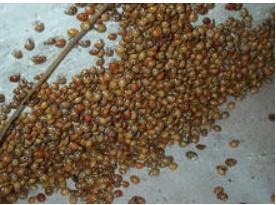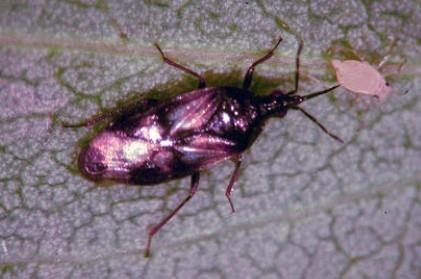By Marissa Schuh
All around us we see how the changing seasons affect our trees, gardens, and the insects that depend on them. Sometimes these changes make the good bugs go bad — as is the case with multicolored Asian lady beetles and minute pirate bugs. These insects spend the spring and summer working hard in our yards, gardens and trees, but as fall rolls around they become an annoyance.

Lady beetle larvae eat the same foods but look very different than adults.
Un-ladylike ladybugs
While we might first think of the multicolored Asian lady beetle as an invasive insect and fall invader, they do a lot of good work in Minnesota’s gardens and crops.
An example of this is in soybeans. Minnesota produces nearly 7.5 million acres of soybeans (14% of Minnesota’s land area). One of the biggest pests in this crop is soybean aphid, which causes yield loss and spread disease from plant to plant. Multicolored Asian lady beetle is a farmer’s biggest ally in dealing with this pest.
Why are they a farmer’s ally? Because these beetles are so hungry! Larval lady beetles can eat an average of 23 aphids a day, and adults can eat anywhere from 15 to 65 aphids per day.
Aphids are also found in gardens, and multicolored Asian lady beetle can be helpful there as well.
Sometimes we see large groups of beetles feeding on fruit, especially apples and raspberries. While the lady beetles often take the blame for the damage, the beetles are most likely to be found on fruit that has already been damaged by weather events or animals.
Unfortunately, the cooler weather drives these beetles to seek out where they will spend the winter. They aggregate on the sunny sides of trees and buildings and look for a way inside, where they will be protected from even cooler temperatures in the coming months. In their native China, the beetles would cluster in caves facing the sun, but the Midwest is short on this type of cave, so your home will have to do.
Dealing with home-invading ladybugs
The multicolored Asian lady beetle can smell bad, bite, and large groups have a major “ick” factor but are not worth spraying with pesticides. They do not spread disease, and spend most of the year helping us grow plants in ways that are hard to quantify. This means the best way of dealing with them is to prevent the beetles from entering our homes.

Lady beetles aggregating in an outbuilding on a farm.
A bonus of many ladybug prevention measures is that they can keep other pests out and lower your heating bill. Now is the time to check the outside of your home for spaces where ladybugs can make their way inside.
- Seal cracks around doors and windows.
- Seal areas where cables and pipes enter your home.
- Patch or replace window and door screens.
- Install door sweeps along doors. If you already have these, check if they are worn down and replace them as necessary.
- Take a look at your garage door seals, and if they are worn or missing, replace them with rubber seals. Rubber works better than vinyl in Minnesota’s cold weather.
- If you are finding them in your attic, inspect your soffits and install insect screens over vents and fan exhausts.
While these steps won’t mean that you will never see a ladybug in your house, they will go a long way in keeping a large number of them out.
If you want to take a more drastic measure, vacuuming can work. Vacuuming won’t kill these beetles (insects are tough). This means that it is important to empty out your vacuum canister or bag so they don't become trapped and continue releasing their bad-smelling defensive compounds.
Read about boxelder bugs for more on keeping out fall invaders.
Probing pirate bugs
n insect that keeps an even lower profile than lady beetles is the minute pirate bug. These bugs are tiny (0.2 inches), oval-shaped, with black and white coloration. Both the good and bad parts of minute pirate bugs involve their straw-like mouthparts.

A minute pirate bug skewers an aphid. Photo: Bradley Higbee, Paramount Farming
Minute pirate bugs spend most of the season hunting other insects, including many common garden pests. They skewer these other insects with their straw-like mouths and then suck the juice out of them. They were an extra helpful pest in a hot summer like we just had, as they feed on aphids and mites, which love hot dry weather.
But what happens when fall comes and their prey starts to disappear? Their mouths get them into trouble. In an attempt to find food and drink, minute pirate bugs will probe things with their mouths. Sometimes, this includes people.
If you noticed an uptick in painful insect bites as the weather cools, minute pirate bugs could be a culprit. The bites can be surprisingly painful, but the pirate bugs do not feed on your blood, inject saliva, or spread disease. It is just a failed attempt at finding something to eat.
Dealing with bites
There isn’t much that can be done about minute pirate bug’s annoying fall behavior. Insect repellents often have no effect on them, and pesticide sprays on houses or in yards aren’t practical.
If trying to avoid bites, take advantage of the fact that these bugs don’t like the cold. Focus outdoor work on cool cloudy days, and otherwise, these bites are just a small part of Minnesota’s four seasons. If you are concerned about a bite, consult your doctor or another trained medical professional.
Source : umn.edu